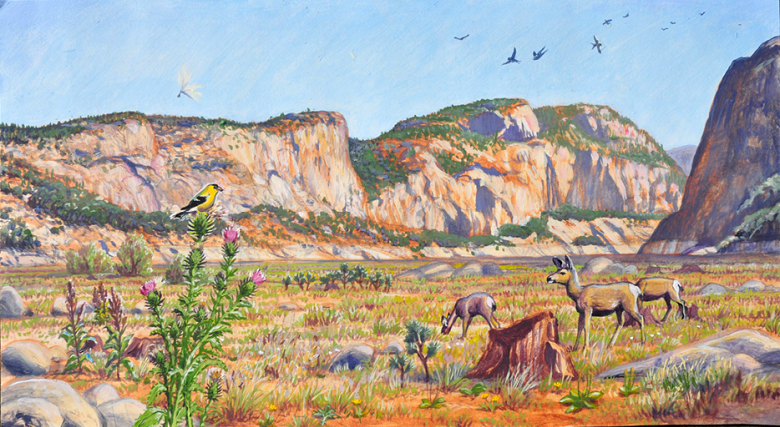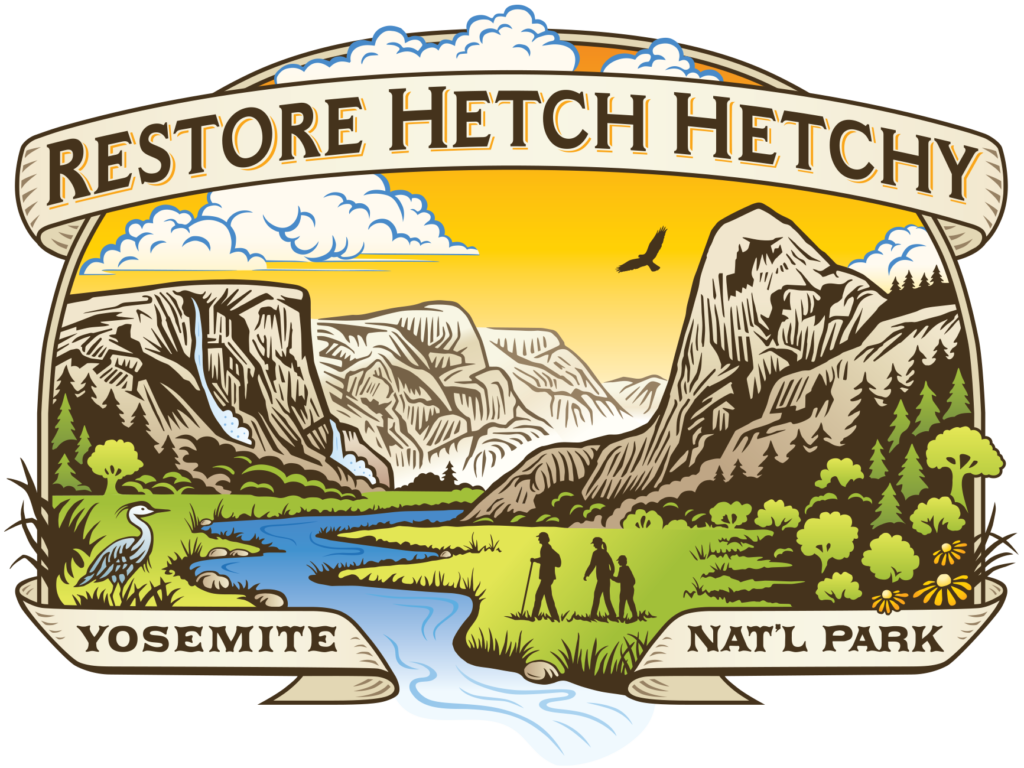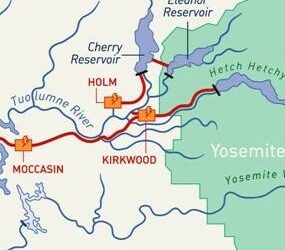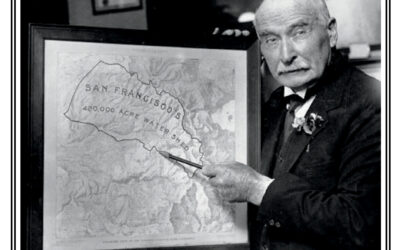Restoration
Numerous studies, including those by the National Park Service and the University of Wisconsin have confirmed that Hetch Hetchy Valley can be readily restored. The only questions are how much human intervention is desirable and to what degree should we let nature take its course.
Removing some dams can be difficult, because sediment can build up over the years. There is little sediment at Hetch Hetchy, however, as the Tuolumne watershed is primarily made of granite.

A restored valley will attract wildlife within a few years, as well as human visitors. Drawing by Laura Cunningham.
The Tuolumne River will immediately return to its natural course. Grasses and sedges will return on their own within a few years, and wildlife will follow.
After the reservoir is drained and the valley floor exposed, native plants can be reintroduced. Revegetation may include planting a mixture of native trees and shrubs: black oaks, black cottonwood, white alder, Douglas fir, dogwood, willow, azalea, manzanita, and ceanothus, to name a few. These species of trees and shrubs will be planted in areas where they originally existed, along with an understory of herbaceous plants.
Non-native plants such as Mediterranean annual grasses may threaten to invade the emerging valley in its first few years, and should be suppressed. The “bathtub ring” from the reservoir will fade naturally and surprisingly quickly, as lichen colonies return. Prescribed burning will be used to prevent conifer encroachment in oak woodlands and meadows, and maintain the fire ecology of the valley as it was before European immigrants arrived.
People from around the world will want to see the reservoir emptied and the famous valley recovering. Engineers, ecologists, environmental restoration experts, native plant and fish specialists, and other scientists will want to study and learn from any and all restoration projects. School groups and the public will be able to observe the process, and some of the cost of restoration could be covered by guided tours for fee-paying visitors.
A restored Hetch Hetchy almost certainly be as congested as Yosemite Valley. Yosemite Valley was developed according to 19th and 20th century conceptions of public access to wilderness. Today, no-one wants to see lines of cars or hotels spread along a monumental valley within a National Park.
We have the opportunity to create an experience of visiting Hetch Hetchy Valley that could be, at least in many respects, superior to present-day Yosemite Valley. We will need a management plan that protects its wilderness character while maximizing opportunities for access to visitors with any sense of adventure – one that visitors throughout California, across America, and around the world will relish.
Responsibility for the design of recreational access to the restored Hetch Hetchy Valley will ultimately be up to the National Park Service, working with public input to implement current best ideals for sustainable, low-impact use.
Shuttle buses or a tramway might provide access to the Valley: other National Parks such as Zion already use one or both of these methods). This no-charge public transport will lead from the park entrance station to the edge of the valley, bringing in visitors and the gear they need to have fun – bicycles, kayaks, fishing rods, ice chests, backpacks, camping gear, etc.

A vision of a restored Hetch Hetchy Valley.
Paths and walk ways would be created; some would provide easy access to the river and points along the valley floor for those wishing to day-hike or for families. Other trails will lead to more remote campsites in the higher reaches of the valley and connect to the existing trail system in the rest of Yosemite National Park.
We’d like to see an unobtrusive visitor center, providing information and education on the history and ecology of the valley. We also highly recommend a cultural contact area where the story of Native Americans who lived in the valley would be told.
You will be able to enjoy nine more miles of the Tuolumne River, now connecting the designated Wild and Scenic River below Hetch Hetchy Valley with the Grand Canyon of the Tuolumne and its headwaters in Tuolumne Meadows. There would be access to side canyons, such as Rancheria Falls, and perhaps a trail ascending Kolana Rock.
Most of all, you will be able to stand, as John Muir once did, waist-deep in grass and flowers, as you marvel at the valley’s towering cliffs and thundering waterfalls. Hetch Hetchy will once again be an iconic valley in Yosemite National Park, and an attractive alternative to its often overcrowded sister valley 15 miles to the south.
Our blog
Our flagship blog features analysis of news from our staff and announcements of upcoming events.
Dams & diversions and water & power
In “Eel River’s rebirth requires sacrifice”, San Francisco Chronicle reporter Kurtis Alexander reminds us that dam removals require balancing the...
Superior Court Judge rules for rivers and against water agencies
The path to restoring Hetch Hetchy will be increasingly easier as San Francisco adapts its system for a future that includes both climate change and...
Our Hetch Hetchy love triangle
The board, staff and supporters of Restore Hetch Hetchy are united by a common thread. We love Yosemite National Park – all of it, and we are...
Join us
Sign up to receive blog posts and other news by email.

Follow us
Stay up-to-date with breaking news and upcoming events.



